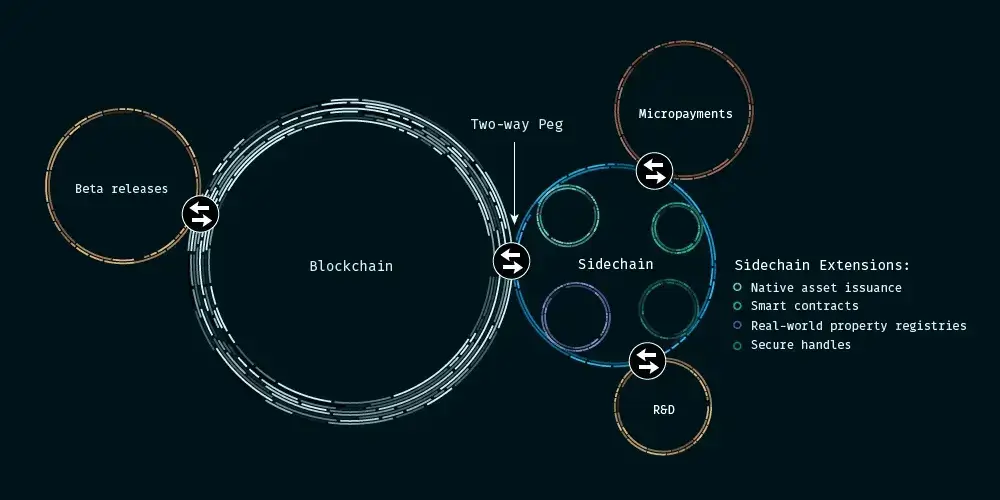Below is a step-by-step tutorial that explains what sidechains are, why they’re useful, and how to approach working with an alpha (early-stage) sidechain environment. While the exact details may vary depending on the specific blockchain platform and sidechain framework you are using, the fundamental concepts remain similar.
What Are Sidechains?
Sidechains are separate, interoperable blockchains that run alongside a main (or “parent”) blockchain. They are designed to extend the functionality, scalability, and efficiency of the main chain without compromising its security. By offloading certain processes or features to a sidechain, developers and users can experiment with new functionalities, process transactions faster, or run specialized applications without overburdening the main network.
Key Benefits of Sidechains
- Scalability:By moving intensive computations and large-volume transactions onto a sidechain, the main chain remains less congested. This can result in lower transaction fees and faster confirmation times on the main chain.
- Flexibility:Different sidechains can be tailored for specific purposes. For instance, one sidechain might focus on smart contract execution while another specializes in privacy-related transactions.
- Security and Risk Mitigation:A well-structured sidechain relies on the security of the main chain for critical operations (such as finalizing asset transfers), but any instability or bugs in the sidechain do not directly compromise the main network. Issues remain contained within the sidechain’s ecosystem.
- Rapid Innovation:Developers can experiment with cutting-edge features in a sandboxed environment on a sidechain before integrating them into the main chain. This approach allows for quicker iteration and safer testing.
What is an Alpha Sidechain?
An Alpha Sidechain typically refers to an early, not fully production-ready version of a sidechain. At this stage, the sidechain’s code, consensus mechanisms, bridge systems, smart contracts, and other components are in active development and testing. The alpha phase is focused on:
- Basic Functionality: Core features are implemented, but not all advanced capabilities or optimizations are in place yet.
- Stability and Compatibility Testing: Developers and early adopters use the alpha network to identify bugs, performance issues, and compatibility concerns.
- Refining the User Experience (UX): Feedback from alpha testers can guide UI improvements, documentation enhancements, and more intuitive developer tools.
Setting Up and Using an Alpha Sidechain
Prerequisites:
- Basic understanding of blockchain concepts (nodes, transactions, blocks, consensus).
- Familiarity with the main chain you’re connecting to.
- Development environment tools such as a suitable programming language SDK, command-line tools, and knowledge of a version control system (like Git).
Step-by-Step Guide:
- Review Documentation:Start by reading the official documentation provided by the sidechain’s developers. Alpha releases often have “Getting Started” guides that detail node setup, configuration files, and any special environment variables required.
- Install Dependencies:
- Ensure you have the right operating system dependencies (e.g., updated package managers, required libraries).
- Download and install any specific command-line tools (e.g., a dedicated CLI for the sidechain).
- Install programming language SDKs if you plan to write smart contracts or client applications.
- Run a Local Node:
- Fetch the alpha sidechain’s node software from its official repository.
- Start a node locally to connect to the alpha test network.
- Verify that your node is syncing correctly by checking logs or using included diagnostics commands.
- Funding Your Test Wallet:
- Create a test wallet address on the sidechain using the provided CLI or a wallet interface.
- Acquire test tokens from a “faucet” (a free distribution mechanism for testnet tokens) or through instructions provided by the developers.
- Confirm that you have test funds by checking your wallet balance.
- Bridging Assets (If Applicable):
- Alpha sidechains often feature a “bridge” to move assets from the main chain to the sidechain.
- Follow documentation to lock assets on the main chain and mint corresponding representative tokens on the sidechain.
- Reverse the process to move assets back to the main chain, ensuring the bridge functionality works as intended.
- Deploying Smart Contracts and DApps:
- If the sidechain supports smart contracts, compile and deploy a simple contract following sample code from the documentation.
- Test contract calls, verify state changes, and confirm that events are logged as expected.
- Experiment with small decentralized applications (DApps) to ensure that the development workflow (coding, compiling, deploying, interacting) is clear and functional.
- Performance and Stability Testing:
- Send multiple transactions simultaneously to see how the alpha sidechain handles increased load.
- Monitor confirmation times, transaction throughput (TPS), and resource usage of your node.
- Feedback Loop:
- As an alpha tester, report bugs, request features, and suggest improvements.
- Join community forums, developer chats, and official issue trackers (like GitHub) to stay updated on known issues and future updates.
Best Practices for Working with an Alpha Sidechain
- Isolate Your Test Environment: Keep alpha sidechain testing separate from production workflows. Use dedicated servers, test wallets, and never risk real funds.
- Frequent Backups: Regularly backup configuration files, keys, and node data. Alpha systems can be unstable, and data may need restoration after upgrades or resets.
- Stay Updated: Alpha software receives frequent updates. Keep track of release notes, changelogs, and documentation updates so you know when to upgrade or adjust your setup.
- Security Considerations: Even though this is a test environment, treat security seriously. Protect private keys, node credentials, and configuration files. Consider running a local firewall and using best practices for secure development.
Conclusion
An alpha sidechain environment provides a sandboxed space to understand and experiment with new blockchain features. By following the setup instructions, exploring its capabilities, and providing constructive feedback, you can help shape the development of this emerging technology. Over time, as the sidechain progresses from alpha to beta and eventually to a stable release, the lessons learned will guide improvements in scalability, functionality, and overall user experience.
